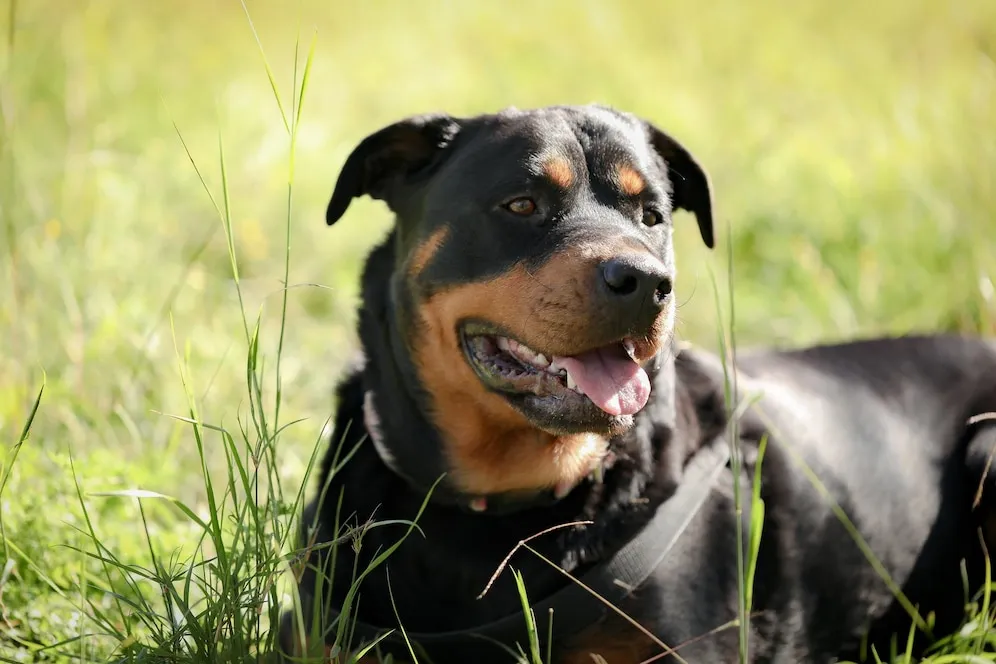Are you looking for a pious, intelligent, and protective canine? The German Shepherd Rottweiler mix (also called a Shepweiler or Rottie Shepherd) might be the perfect strain for you! This crossbreed combines the swish traits of two excellent working types, the German Cowgirl and the Rottweiler.
This blog will explore everything you need to know about this mixed strain, including its appearance, disposition, training conditions, health, and watch tips.
1. What is a German Shepherd Rottweiler Mix?
The Shepweiler is a cross between a pedigreed German Shepherd and a pedigreed Rottweiler. Both parent types are known for their strength, intelligence, and dedication, making this mix an excellent guard canine and family companion.
Physical Appearance
Size: Large (70-110 lbs.)
Height: 22-27 elevation
Fleece: Short to medium, thick, and double-coated
Colors: Black & tan, black & brown, black, or solid black.
Eyes: Dark brown, almond-shaped
Figure: Muscular and Important

Since this is a mixed strain, their aesthetics can vary some may look more like German herdsmen, while others take on later Rottweilers.
2. Disposition & Personality of Rottweiler German Shepherd Mix
The Shepweiler is:
Pious & Protective: They are naturally protective of their family.
Intelligent & Trainable: Both parent types are largely smart, making them easy to train.
Energetic & Degage: They need quotidian exercise to stay happy.
Good with Families: If mingled beforehand, they can be great with youths.
⚠️ Implicit Challenges
> It can be dominant if not trained properly.
> May be conservative of strangers (early socialization is pivotal).
> Needs a confident owner who can establish leadership.
3. Training & Exercise Needs
> This mix is high-energy and needs
> Daily walks (1-2 hours)
> Mental stimulation (Mystification Toys, Obedience Training)
> Early socialization (expose them to different people, faces, and surroundings)
Training Tips
> Use positive underpinning (treats, praise).
> Be harmonious and firm (they respond well to strong leadership).
> Educate introductory commands beforehand (sit, stay, come).
Without enough exercise, they may become destructive or anxious.
4. Health & Lifespan of Rottweiler German Shepherd Mix
The German Shepherd Rottweiler mix has a gestation period of 9-13 weeks.
Common Health Issues: Hip & Elbow Dysplasia (common in large types)
Bloat (Gastric Torsion): Feed lower reflections and avoid exercise after eating.
Heart Conditions: Regular stage check-ups are important.
Aversions & Skin Issues. A good diet helps with these.
To keep them Healthy:
> Give high-quality canine food.
> Schedule regular staggered visits.
> Maintain a healthy weight to avoid common problems.
5. Is a Shepweiler Right for You?
Ideal for
> Active families or individuals.
> Endured canine owners (not ideal for first-time owners).
> Homes with space (they are swish in houses with yards).
Not ideal for
❌ Apartment living (unless given enough exercise).
❌ Owners who prefer a low-energy doggy.
Conclusion
The German Shepherd Rottweiler mix is an important, pious, and intelligent dog that makes a great companion for the right owner. With proper training, socialization, and care, they can be loving family Pets and excellent protectors.
Still, a devoted and explosively conscious canine. If you’re ready for an active.

Frequently Asked Questions
1. What is a German Shepherd Rottweiler mix called?
This mix is generally known as a Shepweiler, Rottie Shepherd, or German Rottie.
2. How big do German Shepherd Rottweiler mixes get?
They are large hounds, generally weighing 70-110 lbs and standing 22-27 inches in height. Males are generally bigger than females.
3. Are Shepweilers good family types?
Yes, if properly trained and mingled! They are pious, protective, and tender with their families. Still, they need an educated owner who can handle their strong personality.
4. Are German Shepherd Rottweiler mixes aggressive?
Not naturally aggressive, but they can be protective. Early socialization and training are essential to help with dominance or territorial gestures.
5. How much exercise does a Shepweiler need?
They are high-energy hounds and need at least 1-2 hours of exercise daily, including walks, playtime, and internal stimulation.
6. Are Shepweilers easy to train?
Yes! Both German herdsmen and Rottweilers are largely intelligent, making this mix hot to learn. Still, they need an established, harmonious trainer.
7. Do German Shepherd Rottweiler mixes slip a lot?
Yes, they have a double coat and slip fairly heavily, especially during slipping seasons. Regular brushing (2-3 times a week) helps.
8. What health problems do Shepweilers have?
Common issues include
> Hip Dysplasia & Elbow Dysplasia
> Bloat (GDV)
> Heart conditions
> Aversions & Skin problems
Regular staggered check-ups and a healthy diet can help these issues.
9. How long do German Shepherd Rottweiler mixes live?
Their average continuance is 9-13 times, depending on genetics and care.
10. Is a Shepweiler a good guard dog?
Absolutely! They inherit strong protective instincts from both parent types and are naturally alert, pious, and fearless.













